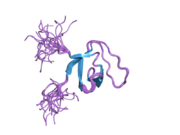From Wikipedia, the free encyclopedia
Osteoclast -stimulating factor 1protein that in humans is encoded by the OSTF1 gene .[ 5] [ 6]
References
^ a b c GRCh38: Ensembl release 89: ENSG00000134996 – Ensembl , May 2017^ a b c GRCm38: Ensembl release 89: ENSMUSG00000024725 – Ensembl , May 2017^ "Human PubMed Reference:" . National Center for Biotechnology Information, U.S. National Library of Medicine .^ "Mouse PubMed Reference:" . National Center for Biotechnology Information, U.S. National Library of Medicine .^ Reddy S, Devlin R, Menaa C, Nishimura R, Choi SJ, Dallas M, Yoneda T, Roodman GD (Apr 1999). "Isolation and characterization of a cDNA clone encoding a novel peptide (OSF) that enhances osteoclast formation and bone resorption". J Cell Physiol . 177 (4): 636–45. doi :10.1002/(SICI)1097-4652(199812)177:4<636::AID-JCP14>3.0.CO;2-H . PMID 10092216 . ^ "Entrez Gene: OSTF1 osteoclast stimulating factor 1" .
Further reading
Maruyama K, Sugano S (1994). "Oligo-capping: a simple method to replace the cap structure of eukaryotic mRNAs with oligoribonucleotides". Gene . 138 (1–2): 171–4. doi :10.1016/0378-1119(94)90802-8 . PMID 8125298 . Suzuki Y, Yoshitomo-Nakagawa K, Maruyama K, et al. (1997). "Construction and characterization of a full length-enriched and a 5'-end-enriched cDNA library". Gene . 200 (1–2): 149–56. doi :10.1016/S0378-1119(97)00411-3 . PMID 9373149 . Sparks AB, Hoffman NG, McConnell SJ, et al. (1998). "Cloning of ligand targets: systematic isolation of SH3 domain-containing proteins". Nat. Biotechnol . 14 (6): 741–4. doi :10.1038/nbt0696-741 . PMID 9630982 . S2CID 11166026 . Schaub R, Dupont B, Roodman GD, et al. (2000). "Assignment of OSTF1 to human chromosome bands 12q24.1→q24.2 by in situ hybridization". Cytogenet. Cell Genet . 88 (1–2): 87–8. doi :10.1159/000015492 . PMID 10773673 . S2CID 41580372 . Kurihara N, Menaa C, Maeda H, et al. (2001). "Osteoclast-stimulating factor interacts with the spinal muscular atrophy gene product to stimulate osteoclast formation" . J. Biol. Chem . 276 (44): 41035–9. doi :10.1074/jbc.M100233200 PMID 11551898 . Strausberg RL, Feingold EA, Grouse LH, et al. (2003). "Generation and initial analysis of more than 15,000 full-length human and mouse cDNA sequences" . Proc. Natl. Acad. Sci. U.S.A . 99 (26): 16899–903. doi :10.1073/pnas.242603899 . PMC 139241 PMID 12477932 . Szymkiewicz I, Destaing O, Jurdic P, Dikic I (2004). "SH3P2 in complex with Cbl and Src" . FEBS Lett . 565 (1–3): 33–8. doi :10.1016/j.febslet.2004.03.100 PMID 15135048 . S2CID 22127534 . Humphray SJ, Oliver K, Hunt AR, et al. (2004). "DNA sequence and analysis of human chromosome 9" . Nature . 429 (6990): 369–74. doi :10.1038/nature02465 . PMC 2734081 PMID 15164053 . Gerhard DS, Wagner L, Feingold EA, et al. (2004). "The Status, Quality, and Expansion of the NIH Full-Length cDNA Project: The Mammalian Gene Collection (MGC)" . Genome Res . 14 (10B): 2121–7. doi :10.1101/gr.2596504 . PMC 528928 PMID 15489334 . Rual JF, Venkatesan K, Hao T, et al. (2005). "Towards a proteome-scale map of the human protein-protein interaction network". Nature . 437 (7062): 1173–8. doi :10.1038/nature04209 . PMID 16189514 . S2CID 4427026 . Li M, Meng Z, Xu Y, et al. (2006). "Crystallization and preliminary X-ray crystallographic analysis of osteoclast-stimulating factor" . Acta Crystallographica Section F . 61 (Pt 1): 128–30. doi :10.1107/S1744309104031653 . PMC 1952375 PMID 16508112 . Chen L, Wang Y, Wells D, et al. (2006). "Structure of the SH3 domain of human osteoclast-stimulating factor at atomic resolution" . Acta Crystallographica Section F . 62 (Pt 9): 844–8. doi :10.1107/S1744309106030004 . PMC 2242886 PMID 16946461 . Olsen JV, Blagoev B, Gnad F, et al. (2006). "Global, in vivo, and site-specific phosphorylation dynamics in signaling networks". Cell . 127 (3): 635–48. doi :10.1016/j.cell.2006.09.026 . PMID 17081983 . S2CID 7827573 . Ewing RM, Chu P, Elisma F, et al. (2007). "Large-scale mapping of human protein–protein interactions by mass spectrometry" . Mol. Syst. Biol . 3 (1): 89. doi :10.1038/msb4100134 . PMC 1847948 PMID 17353931 .








